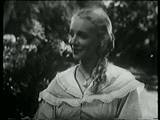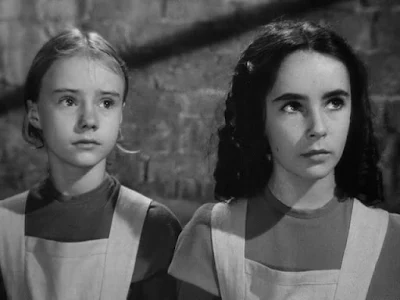Classic Reel: Jane Eyre
To mark International Book Lovers' and International Women’s Day, which took place this week, let’s talk about one of the most memorable heroines in Literature - Jane Eyre. She has been portrayed by several actresses in Movies, TV serials, plays, radio and musicals for decades. With so many adaptations, just one classic version of Charlotte Brontë's novel draws the long straw for this week’s 'Classic Reel Thursday'. And as this is a well-known story, the rules of 'no spoilers' will be relaxed today.
Cast: Joan Fontaine, Orson Welles, Margaret O'Brien, Agnes Moorehead, John Sutton and Sarah Allgood
Directed By Robert Stevenson
Year of Release: 1943
Plot: Unwanted in her harsh aunt's household, an orphan is sent to a charity home/school where she faces even harsher treatment. Years later, she finds work as a governess to a rich, but mysterious man's daughter.
This version is not exactly faithful to the book, but a lot better than the 1934 one, starring Virginia Bruce and Colin Clive. You wouldn’t expect a movie adaptation to be faithful page to page, but that one had far too many creative liberties, and so many things were changed that it more or less departed from the actual storyline.
Plus, Virginia Bruce wasn’t Jane, even though she tried really hard. The main thing against her was her looks. None of the actresses who played Jane Eyre was plain (as Jane is supposed to be), but Virginia was far too beautiful for the part, plus she was tall with golden blonde hair, when Jane was supposed to have dark brown hair and be petite in stature. Rochester is supposed to be the epitome of a Byronic hero- dark, brooding and mysterious. Clive’s Rochester was far too nice! Interesting to watch because of the period it was made and released, but simply not a good adaptation.
Moving on.
In the 1943 version, Jane was played by Joan Fontaine and played as a child by Peggy Ann Garner. As the novel was told in Jane’s point of view, i.e. first person narrative, there were voice-overs (done by Fontaine) narrating modified passages in the book. However, considering the novel itself is in 38 chapters, it still portrayed the spirit of the book in 1 hour and 37 minutes.
At the beginning of the movie, we see Jane (Garner) being punished for defending herself against her bullying cousin, then introduced to the administrator of the charity school and home she was going to, Mr Brocklehurst. One of the most hated characters in literature, Henry Daniell’s portrayal made him hated even more- cold, arrogant, hypocritical and remorseless at the way he treated the orphan girls at Lowood Institution, plus (no offence to the actor) a face you just wanted to slap!
Peggy Ann Garner was wonderful as young Jane, delivering her lines beautifully, and there was nothing exaggerated about her acting. Her best friend, Helen Burns, was played by Elizabeth Taylor (in a very early role but uncredited). One could immediately see the beautiful woman she would be years later, and while she could have been more fragile in appearance, like Helen was supposed to be, Taylor’s acting, particularly the part where she and Jane had their last conversation before her death, was heartrending. Elizabeth Taylor was 10 years old at the time, making her a bit young for the role, as Helen Burns was supposed to be a few years older than Jane.
Jump 10 years later, Jane is now played by Fontaine. Fontaine played a somewhat subdued but dignified Jane Eyre, and unlike Virginia Bruce, her beautiful face didn’t make her look out of place. And she made Jane look like she’s put her harsh childhood and school life behind her and simply wants to make her way in the world and take control of her life. Her Jane was gentle but plainly not a pushover; Jane was no pushover in the novel anyway.
If you read the novel and visualise Rochester, Jane’s employer and later love interest, the actor that would come to mind (besides Timothy Dalton in the 1983 BBC version) would be Orson Welles. He was every inch the Edward Rochester Miss Brontë described.
Jane and Rochester were formally introduced in the novel by Mrs Fairfax; the housekeeper and he interview Jane while having tea with her, Mrs Fairfax and Adele.
But in this version, their first conversation was quicker than the novel version. Not only were Adele and Mrs Fairfax absent, the moment Jane entered the study, Rochester signalled her to pour hot water from the kettle for his hurt foot; checking her out the whole time, his bare leg for her to see. Not sure Miss Brontë would have approved of that. It seemed really inappropriate, especially since Jane is a governess, not a maid or his valet.
Jane and Rochester were formally introduced in the novel by Mrs Fairfax; the housekeeper and he interview Jane while having tea with her, Mrs Fairfax and Adele.
But in this version, their first conversation was quicker than the novel version. Not only were Adele and Mrs Fairfax absent, the moment Jane entered the study, Rochester signalled her to pour hot water from the kettle for his hurt foot; checking her out the whole time, his bare leg for her to see. Not sure Miss Brontë would have approved of that. It seemed really inappropriate, especially since Jane is a governess, not a maid or his valet.
His interaction with Fontaine as their characters get to know each other and fall in love is intense to say the least; you can actually feel it when he talks to her and looks at her. He's gruff but a bit more affectionate towards Adele (Maureen O' Brien), anxiously going with Jane to check on Adele after the fire and playfully asking her much later if she approved of him marrying 'Mademoiselle'.
His declaration of love and proposal of marriage was heavy with passion and would have had the viewers on the edge of their seats. One would think it would be followed by a hot kiss between him and Jane, but it wasn't, which was disappointing. Still, his words to Jane were pure gold, yet a bit rushed, spoken urgently, almost as if he was daring her to refuse him, punctuated by the dramatic music and the flash of lightning and rumbling thunder.
He: Jane, you strange, almost unearthly thing. You know that I love you as my own flesh.
Jane: Don't mock me now
He: I have no love for Blanche, it's you that I want. Answer me, Jane, quickly... say it, "I'll marry you", say it, Jane, say it!
As a marriage proposal goes, not bad, but still, why wasn't it followed by a kiss instead of just holding her tightly? Not fair at all. But at least we got treated to Jane, Rochester and Adele on a happy shopping spree and Rochester taking Jane to the races, smiling all over his face and Jane looking so radiant.
His declaration of love and proposal of marriage was heavy with passion and would have had the viewers on the edge of their seats. One would think it would be followed by a hot kiss between him and Jane, but it wasn't, which was disappointing. Still, his words to Jane were pure gold, yet a bit rushed, spoken urgently, almost as if he was daring her to refuse him, punctuated by the dramatic music and the flash of lightning and rumbling thunder.
He: Jane, you strange, almost unearthly thing. You know that I love you as my own flesh.
Jane: Don't mock me now
He: I have no love for Blanche, it's you that I want. Answer me, Jane, quickly... say it, "I'll marry you", say it, Jane, say it!
As a marriage proposal goes, not bad, but still, why wasn't it followed by a kiss instead of just holding her tightly? Not fair at all. But at least we got treated to Jane, Rochester and Adele on a happy shopping spree and Rochester taking Jane to the races, smiling all over his face and Jane looking so radiant.
All in all, this was a great adaptation. Not only will you be treated to a great performance by the cast, including Maureen O' Brien, who played Adele so angelically, along with an authentic French accent (her predecessor in the 1934 version spoke in an English accent, which was not right), but also to the Gothic setting, which was in keeping with the story's period. The gloomy Thornfield Hall and the foggy moors reflected Rochester's broody nature and the secret he was hiding from Jane... he's a married man.
And while some parts and characters were cut, it still depicted some social issues Miss Brontë highlighted in the book. For example, there was the mistreatment of orphans as shown in a heartbreaking scene where Jane and Helen are punished by walking about in the rain, holding heavy weights. Mr Brocklehurst shows his disgusting hypocrisy by insisting he was feeding the girls' souls. Yet they have frozen water to use to wash, little food to eat, thin cloth as uniforms and their natural curly hair cut to curb 'their vanity.'
And there was the theme of feminism, Jane insisting on taking control of her life instead of giving in to Brocklehurst's offer and morality, when Jane refused to stay on at Thornfield Hall after finding out Rochester was still married, even though his wife was insane. You can't help but feel sorry for him because he was a victim, tricked by his own father and brother to marry a permanently insane woman, yet still applaud Jane for refusing to give up her self-respect, and applauding more when she and Rochester get married after his wife dies.
Some scenes and characters were omitted, yes, but the movie still managed to cover the book's main plot and close a few subplots. The night of the fire, Rochester told Jane who Adele's mum was and why their relationship ended. John Rivers, who was supposed to be Jane's cousin and brother of her two other cousins, Diana and Mary, was changed to a doctor who tended to the Lowood girls and befriended Jane, acting as her mentor. And after leaving Thornfield Hall, Jane goes back to her aunt's house, Gateshead, instead of losing her way and is reconciled with her harsh aunt, who is dying, at the same time finding out the cousin who bullied her was dead.
And when Jane finally goes back to Thornfield Hall after hearing Rochester cry out her name from far away, do we finally get the long-awaited on-screen kiss between them and the final scene is the now married couple walking on the moors.
And when Jane finally goes back to Thornfield Hall after hearing Rochester cry out her name from far away, do we finally get the long-awaited on-screen kiss between them and the final scene is the now married couple walking on the moors.
Omissions aside, this movie is a masterpiece.
















Comments
Post a Comment